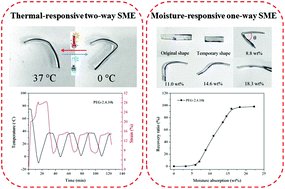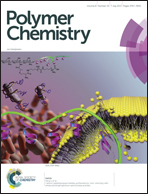Body temperature-responsive two-way and moisture-responsive one-way shape memory behaviors of poly(ethylene glycol)-based networks†
Abstract
In this work, crosslinked shape-memory polymer networks were prepared by thermally induced free-radical polymerizations of methacrylate-terminated poly(ethylene glycol) (PEG) and n-butyl acrylate (BA), which integrate thermal-responsive two-way and moisture-responsive one-way shape memory effects (SME). Broad molecular weight distributions of PEG were employed with the aim of tuning the transition temperatures close to that of the human body and achieving a broad transition temperature range. The resultant PEG-2,4,10 kDa and PEG-2,6,10 kDa networks showed good thermal-responsive two-way reversible shape memory effects between the human body temperature and 0 °C, with the two-way recovery ratios of 8.2% and 6.2%, respectively. Furthermore, the crosslinked networks were found to be moisture-responsive and the deformed specimen was nearly recovered to the original shape (98% in the recovery ratio) when exposed to the moist atmosphere. These features, along with the inherent biocompatible properties, have great potential in biomedical applications.



 Please wait while we load your content...
Please wait while we load your content...